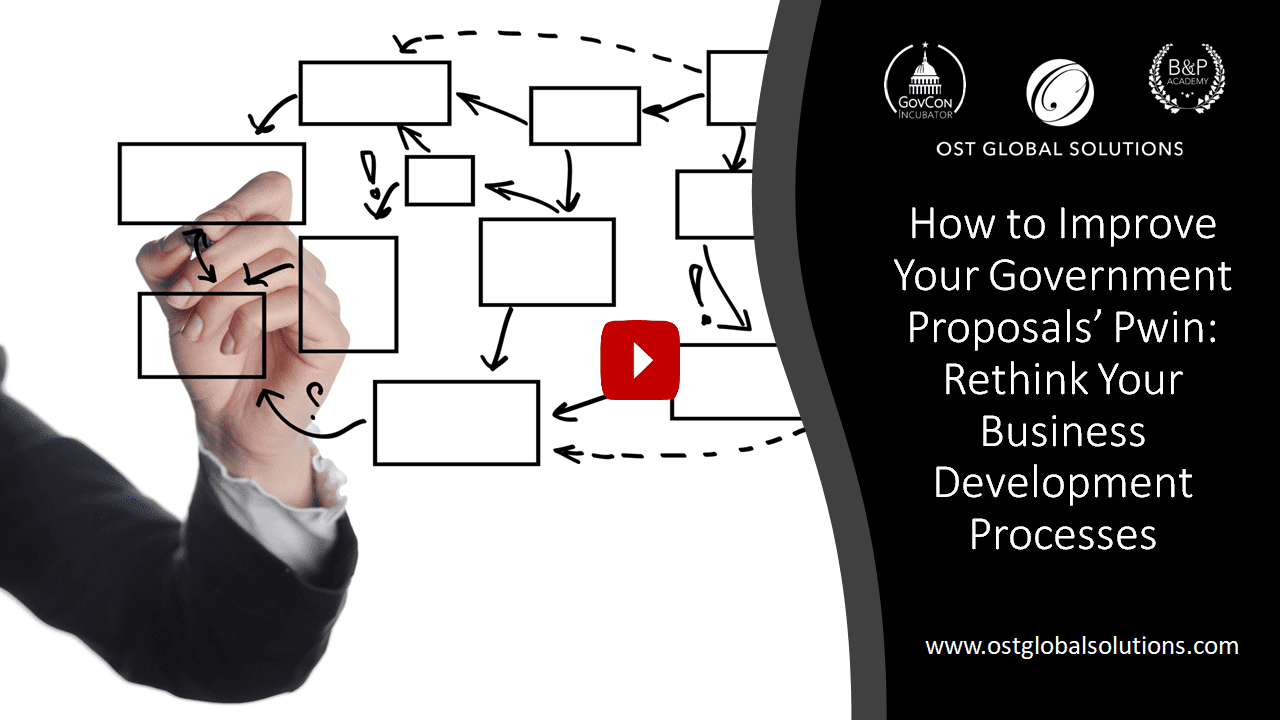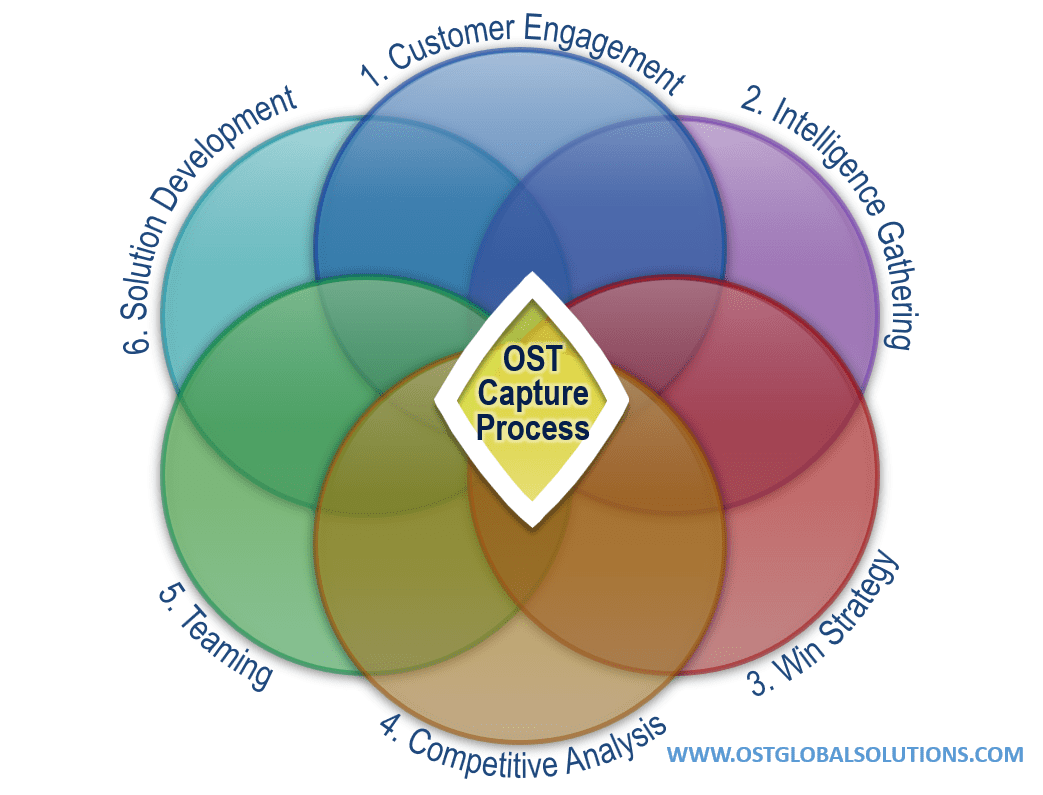This week, we continue with our seven-part webinar and article series on How to Improve Your Government Proposals’ Pwin. The first article focused on assessing your proposals’ performance, while the second explored changing business development culture. Today, we hone in on how your business development processes can raise or lower your win probability (Pwin).
What Sort of BD, Capture Management, and Proposal Management Processes Should You Have?
Basically, for a Government contractor, there is no “one size fits all” in terms of business development, capture, and proposal processes.
A company requires various business development, capture management, and proposal processes based on the opportunities they choose to pursue. How are you competing for new business opportunities (large or small)? How are you preserving and growing your current Government contracts? Are you conducting oversight of your business development processes?
As a federal contractor, you need multiple business development, capture, and proposal processes. This allows you to tailor your approach to winning each opportunity you pursue.
You need a process for winning new business, which differs from the process for winning recompetes. You may also have a different process for capturing large and small Government contracts. Both processes may vary in terms of the level of effort and in steps.
Your “farming” process will be different from the competitive capture and proposals. It will focus on preserving and growing your footprint with your current Government customers.
You will also need a process for overseeing your BD, capture management, and proposal activities that includes decision gates and meaningful metrics.
Basically, for a Government contractor, there is no “one size fits all” in terms of business development, capture, and proposal processes. Your organization needs BD processes tailored to each type of situation and opportunity you tend to encounter.
Throw Out an Old Waterfall Approach and Use Modern Methodology for Your BD, Capture, and Proposal Processes
Perhaps you have documented processes, or maybe you don’t. Documented processes can trick your mind though. They often look good on paper, but either fall apart on execution or no one actually follows them. When you evaluate your business development processes, ask these questions:
- Does everyone know their action items and deliverables?
- Do they know their deadlines and the consequences for missing said deadlines?
- Are workflows between team members clear?
- Have you explained to your employees their level of authority and decision-making ability?
The Era of the Waterfall Process for BD, Capture, and Proposals is Over
The Waterfall Process in software development is linear and therefore more restrictive. Someone sets the outline, and authors get their assignments and deadlines. The proposal manager cracks their whip to ensure everyone submits their sections by the deadline. Usually in time for a color review such as a Pink Team or Red Team.
A process tsar will hold onto the steps of this process no matter what, making sure that every section of the proposal gets filled with text and graphics. If a color review is scheduled to happen, then it’s happening on that date, even if your proposal is still in a rough shape; it doesn’t emphasize the constant involvement of the proposal manager and capture manager in the content.
The Waterfall Process consumes a lot of resources at each step. It is hard to pivot when changes need to be made either due to RFP amendments or because of evolving technical or management approaches. Let go of this old-fashioned process style.
Flexible and Agile BD, Capture, and Proposal Processes Improve Your Pwin
The best business development, capture, and proposal processes will permit you to use your team’s capability to its limit. They reflect the resources and time for capture or proposal you have right now, as opposed to a hypothetical scenario of how things “should be.” Using more agile processes will allow the development of various components of your plan based on principles instead of strict instructions. You will define priorities based on the thought processes behind each action instead of simply following the prescribed steps.
Things you need to establish: clear levels of decision-making authority, responsibilities, and workflows.
How Agile Software Development Methodology Assists in Capture Management and Proposal Development
Part of staying fresh and innovative is taking your inspiration from different successful methodologies. Take for example, how Agile software development methodology applies to the world of capture and proposal development.
How do Agile principles like Scrum and Kanban come into play? You can use the ideas behind them to fashion flexible and agile proposal development processes:
Scrum principles: Rapid iteration, constant communication within a small time box.
- How Scrum principles manifest in proposal management: Communicate daily about section and action item completion progress; If you haven’t seen a proposal section or graphic draft, it doesn’t exist.
Kanban Principles: Lean process with just-in-time training.
- How Kanban principles manifest in proposal management: You must train your team to be competent in every step of the proposal process, just in time for a certain activity. Don’t be overly bureaucratic with proposal activities: for example, you don’t need to document and officially disposition every single reviewer comment to have a winning proposal.
Agile Proposal Management Examples include:
- Conducting short targeted brainstorm meetings covering specific topics, with only the necessary people attending.
- Making incremental progress every day, with the proposal manager making it a priority to move the proposal content forward consistently.
- Holding daily in-process proposal reviews to always know exactly what is going on.
- Reassigning resources and shifting assignments, if necessary.
- Adjusting the goals or even dates of color reviews such as Pink Team and Red Team based on proposal readiness status; it may be that the goal of a color review is to complete the proposal and move it forward some more if it is still raw.
If these steps sound intensive, that is because they are. This ties back to having a winning mindset woven into your business development culture. Losing proposal momentum for any reason can take an opportunity for an outstanding proposal and turn it into a “submit-by-the-deadline” proposal.
Read about one of our actual experiences in which a client lost proposal momentum, and how to avoid it.
Applying Agile to Capture Management
Borrowing from Agile will help improve your capture process as well. Get away from linear capture steps that culminate in slide decks and plans that look good on paper but don’t move you closer to winning. You’ll enable your team to focus on what matters for raising your Pwin.
Agile Actions to Take in Capture:
- Conduct early win strategy sessions in short 2-3 hour meetings.
- Iterate the win themes messaging and complete action items between meetings.
- Assign strategic action plans for complex actions that focus on the outcome, not the specific steps; it’s up to the person who owns the action item to determine the best way to reach the desired outcome.
- Supervise action item completion status and change direction where required.
- Stop pursuing opportunities when the team fails to make progress in capture and complete the assigned action items.
We have developed a holistic capture management methodology that embraces agile business development processes. Learn more about our capture strategies here.
Optimize Your Business Development, Capture, and Proposal Processes
You should optimize your business development processes continuously. This way, you can rest assured knowing that your team uses the best approach time and time again. You’ll need to consistently evaluate what is important, and what needs to be let go.
It is the proposal content and price that help you win a federal contract. Is everything you do in capture and proposals directed towards improving content and price?
When do you see the best results? Is it through a clear solution, compelling evidence, engaging graphics, solution to price, etc.?
Don’t forget: content and price are kings, but your process is the enabler.
If your process isn’t helpful, rethink it. Don’t cut out steps for efficiency’s sake. For example, on a short turnaround proposal, you may not conduct a Pink Team review. Don’t do away with a review altogether. You could run a smaller review session with just the proposal leadership, or conduct a peer review.
Just ensure that someone checks your work and the overall proposal direction. A good review always improves your proposal by at least one grade.
Collect your lessons learned at the end of each proposal and after each proposal debriefs, and always strive for improvement. Don’t move on without reviewing your lessons learned prior to each proposal. Assessing your proposal quality (and how you achieved that quality) is another key method for improving your Pwin.
What If I Need Help With My Business Development Processes?
OST offers a series of services and training that focuses on what it takes to win federal contracts. You can schedule training from our Bid & Proposal Academy on Capture Management and Proposal Management. Our Writing Persuasive Federal Proposals course focuses on speed writing and engaging every member of your team, turning your workforce into your sales force.
If you found this article helpful, be sure to subscribe to OST’s Turbo Charging Growth Newsletter. We’re producing four more videos and articles on methods for improving your Pwin that you won’t want to miss.
After reading this article and watching the video, where do you think your business development, capture, and proposal processes could use improvement? Do you think we missed something? Let us know in the comments section, and we’ll get back to you.
Contact us to learn more.




